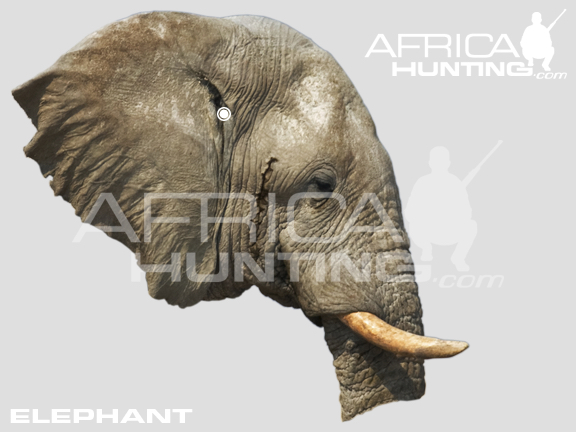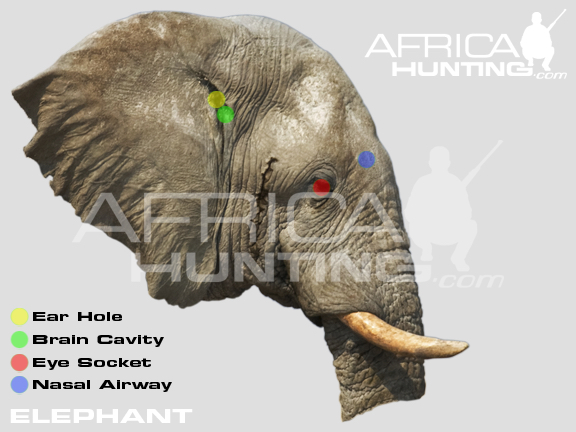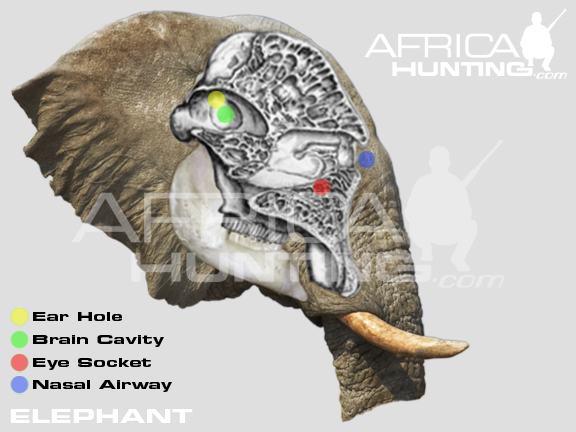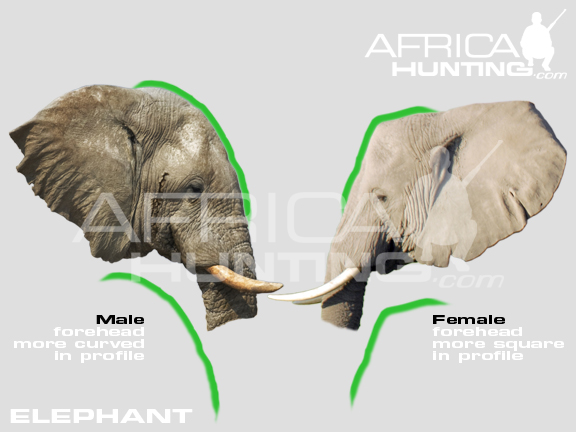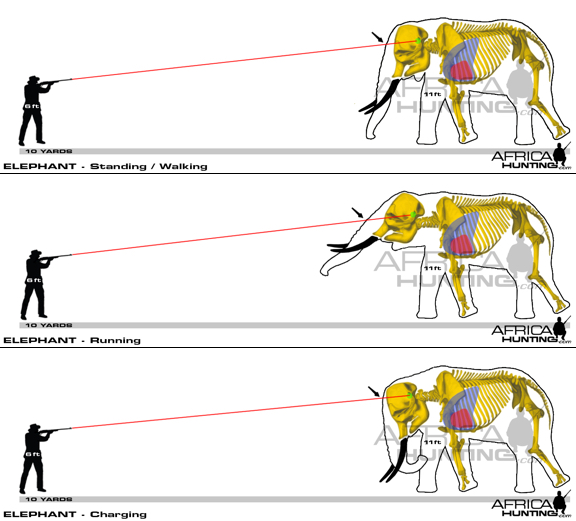Elephant Hunting & Cartridges
Elephant Hunting & Cartridges
by Dr. Jo Hall
Given proper bullet placement and a well constructed projectile of decent sectional density virtually any centre fire rifle will kill elephants very handily.
Many elephant, including some superb old tuskers, were killed by the professional ivory hunters in the first half of the 20th century with a variety of small bore rifles of the 6.5mm and 7mm class as well as .303 , 318 and similar calibres. In more recent times countless elephant have been slain by poacher’s AK47’s firing their pitiful little 30 cal. cartridge.
Culling operations in southern Africa have also demonstrated on thousands of animals that the FN self loader with the 7.62 NATO cartridge is a deadly and effective tool in the hands of experienced and proficient hunters.
There is no argument that these small bores can be used to KILL elephants, but what is more interesting to most of us lucky enough to get the opportunity to hunt elephant is the question as to what is a sensible and adequate calibre with which to follow up the great grey fellows in the thick stuff, and to end the life of the mightiest and most wonderful animal on the earth.
Hunting these mighty creatures carries with it the responsibility to get it right and to kill them cleanly for the sake of the animal, but also for your own sake and the sake of your trackers, bearers and PH, because they are formidable and lethal opponents and take injury very personally.
Many hunters and their companions have paid the price for poor shooting or for using inadequate calibres. Elephants must be instantly killed or so severely disabled with the first shot that they are unable to mount a retaliatory charge. This means in practice preferably a brain shot or, failing that for whatever reason, a shot into the great vessels above the heart, passing on through lung tissue and if possible exiting through the opposite side of the chest.
One of the most useful aspects of the brain shot is that, apart from the instant collapse and painless demise of the animal shot, it is relatively undisturbing to the rest of the herd and far less likely to initiate a retaliatory response from another elephant than if the shot jumbo screams or trumpets in pain and upsets its family and companions. Elephants are intensely social animals and feel the hurt of those close to them.
And, unlike most animals, elephant are quite likely to take matters into their own hands if they feel that they or their calves or friends are threatened and may initiate a murderous charge that inevitably will have a fatal outcome for either attacker or those attacked because, unless the charge is terminated, some-one will be very thoroughly killed by the irate beast.
So, hunting elephant always carries with it the likelihood of a sudden close quarter charge and the rifle used needs to be able to deeply penetrate and kill, or at least turn the charge, even if the bullet is poorly placed as, in the excitement of such moments, it is likely to be. The bullet needs to be as large in calibre, as strong in construction, as blunt in form and as long as can be stabilized as possible.
On one occasion when hunting tuskless cows we had moved in on a small bunch of cows and calves under the shade of a baobab in the middle of the day. We had checked the sighting of the 450 Ackley that I cradled only an hour before. The Woodleigh solids had cut each other at 90meters just where I had looked.
Urged along at 2360fps by 97 gn of the lot of W748 I used at that time they had proved formidable medicine for Cape buffalo on other hunts and should prove adequate for elephant .
We crouched in the open dust 20 meters off the mob and waited for them to move for a clear shot at the tuskless cow that was jammed up in the middle of the group. The November sun in the Zambezi valley was blinding and the mopane bees relentless as the sweat poured down and the wind started to twitch around. A cow’s trunk went up and the mob stepped clear of the shade as they whiffed us.
The tuskless cow was in front and the 450 Ackley crashed, the bullet too far forward for the brain, but she buckled and staggered forward, the Ackley reloaded and another bullet into the chest, and another and she started to roll as the last solid went into the shoulder and the rifle was empty. With a scream she went down with a thump in a rising cloud of dust and it was over.
But then Ian Gibson was yelling to run, that another cow was coming and the furious screams and trumpeting cut through the focus on the downed cow and the rifle was empty and I was off like a scalded cat to put some distance behind me and reload on the run. Off 50 meters and pulling up beside a tree, thumbing cartridges into the rifle, listening to the screams of the cow as she hunted for revenge, I waited for whatever was to come. She had found one of the tracker’s hats on the ground and attacked that, but it was only a momentary distraction until she took up the scent to find one of us. She found Ian who had stood his ground and she found a 458 solid above the eyes instead of the revenge she was after. It was a pity to kill her too, but there was no choice for she was intent on vengeance .But it is hard not to respect an animal so attached to its family and so determined to protect it as to press home the charge.
My first shot on the tuskless cow was poorly placed, forward of the brain , but it hit hard enough to shoot through the head and stun her long enough to get in killing chest shots.
A lesser calibre than the 450 Ackley, with a smaller bullet, may not have done so and she may have escaped essentially unhurt or with a slowly lethal injury. I know that if I shoot poorly as in this case, then I’d prefer to do so with the biggest calibre possible, It is very doubtful that Bell’s favourite calibres, the 6.5mm and 7mm would have stunned this cow at all, if placed in the same place. It is most likely that she would have bolted off with a hole through her head, but no real damage done.
I freely admit I am no elephant hunting expert, but I have been lucky enough over quite a few years to hunt elephant many times and to walk down their dusty tracks for hundreds of kilometres following the trackers and the PH, checking the freshness of the spoor and celebrating the increasing warmth of the dung heaps as we got closer, until the soft sound of the dung dropping or the sounds of feeding told us they were close by.
Many times the big fellows simply walked away from us and we never saw them. Some times we got amongst them and looked them over and, finding nothing that we wanted, we just walked away from them. To walk an elephant down is cause for satisfaction in itself and the shot can be an anti-climax, not really necessary to the nature of the exercise.
Sometimes we would close on a good bull or a large tuskless cow and ,after getting in as close as possible, the moment of truth would arrive and there could be no alibis. Anyone shooting at an elephant has to be confident in his arms and his ability to use them.
After having carried a variety of rifles and calibres and used them to take elephant on a number of occasions I have some personal favourites for the work.
All the rifles and calibres I’ve used were at least adequate for the worst case scenario and some were perfect under most circumstances. My experience is limited to say the least, certainly if measured against that of the old ivory hunters and the professional cullers, but is probably similar to many who have had the good fortune to hunt the greatest game on earth.
It had been raining on and off for weeks in the Zambezi Valley and we drove out in the drizzle of a wet predawn, the Toyota’s tyres hissing through the sand of the wheel tracks. The wet season had run on late and the jumbos were raiding the mealey fields in the early hours after midnight and moving off into the mopane scrub to escape any retribution during the day. Night jars fluttered off the road in the truck lights like moths as the drizzle filtered down. The herd had crossed the road hours before, leaving tracks of cows and calves and two herd bulls amongst the fragments of mealey stalks they had been chewing. They had raided from the National park across the river and were probably heading back to safety before we caught up with them and exacted the price for their crop damage.
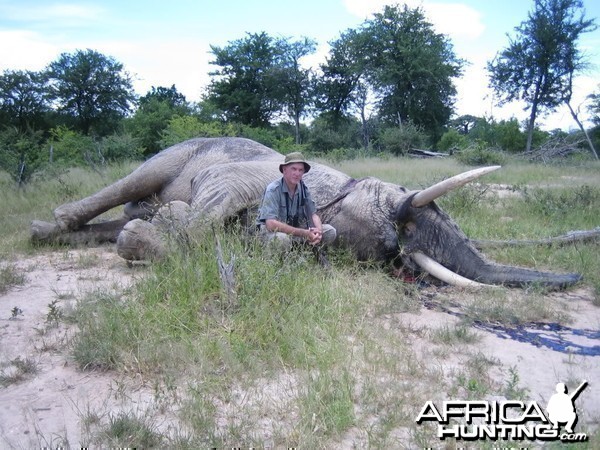
In reality, most of the hunters I know would prefer to see the elephants free to roam and raid as they want and go unpunished for it, but it is a sad irony that we hunt these sagacious creatures so that people can expand their range and displace the great pachyderms from the world. Unhappily, the old Africa of a sea of elephants dotted with islands of people has changed to the current dreadful tsunami of people swallowing up the ancient tribes of elephant and leaving them isolated in their shrinking ranges.
As the darkness faded and the drizzle eased we moved off on the tracks, following the herd as it split and separated, feeding idly along and then regrouping for another march to the next rest point.
They were clearly relaxed and ambled easily along, pulling down trees for a mouthful of leaves and for the sheer fun of doing it. The bushveld is constantly formed and contoured by the elephants’ passage as they forage and pull down the trees. Their careless vandalism shapes the African bush in the way they need to continue providing their forage and provides space and plant growth for all the other creatures of the bushveld.
Even while they swung along quietly, resting every hour or so, we gained on them slowly. They followed one of the bush roads for a while before swinging off into the hills. A trio of sandgrouse erupted with a rattle from the road as we followed, the spoor becoming fresher. Squeezing fresh elephant dung balls, the wet heat stained our hands. Plunging into the grass pressed down by their passing through we moved on, the distant crack of breaking branches carrying down the valley.
They were scattered, a dozen of the great steady beasts feeding through a low valley between the hills. We moved into the wind along a low ridge, several elephant just ahead of us in the scattered scrub. A young bull was standing alone at the end of the ridge, fanning his ears, apparently just thinking about things as we closed on him.
Loose rocks rattled as we got to within twenty meters. His ears went out and he stepped forward, sensing a threat. Seizing a young mopane tree with his trunk, bending and breaking it and swinging it around in what looked like a demonstration of power he seemed about to come. The 470 was up and the bead sat on his forehead between eye and ear. He started to turn and his head was clear of branches and the double bucked, the solid crashing into the brain, through the whole skull and out, deep into the neck, blood and brain matter flying out of his ears. He crashed like a stone, taking another mopane with him. Reloading on the run, behind him and another 470 crashed into the top of the skull, the whole head lifting off the ground with the impact. Reloading, we moved to the ridge, getting as high as we could, waiting for the herd to react.
With shrieks and trumpeting they gathered and bolted off, back towards the park, hopefully to stay there until their fear and memories faded. The 470 loaded with a 500gn solid to 2125fps had performed as well as it always had since being introduced by Lang. It had quickly become a standard of the gun trade as a non proprietary cartridge and soon became the most common double rifle chambering for a “heavy”.
Even today it is the most common chambering in new heavy “stopping” double rifles.
My loading of 93gn AR 2209 and a foam wad behind a 500gn Woodleigh solid duplicates the standard load and regulates in the four doubles in this calibre that I’ve used.
The 500 Jeffery was a late arrival in the ranks of the great elephant cartridges and came at a time of the collapse of the ivory market, just before the Great Depression. Only 24 of the heavy bolt rifles were ever retailed by Jeffery, all of them, as far as I understand, built by Leonard in Birmingham. The 500 J is a stumpy, rebated rim case, designed to use flake or extruded tubular powders rather than the cordite used in all the British rimmed cases and its great British competitor, the 505 Gibbs. It was probably originally German designed to fit the standard K98 Mauser action and was certainly loaded by the German ammunition companies before being rebranded by the British. It is an effective round for the biggest game although it is handicapped in original factory loads by a lighter projectile than is desirable. The standard 535 gn bullet is easily driven at 2400fps and this makes it a powerhouse, but it is better matched with a 570gn or 600gn projectile at about 2200fps to get the most out of it. The 535 gn bullet is a little too short for best penetration and, at the velocity of which it is capable in the 500 J, it is inclined to be a bit unstable against elephant tissue and bone. I have shot enough of them into elephant to be confident about this. It is not too difficult to bend, split, flatten or otherwise damage the usual steel jacketed 535 gn ‘solids’ on shooting into heavy elephant bone and such damage is a certain way to deflect the projectile and send it off course. This can get you killed if the bullet misses the major nerve structures of brain or spine , or the heart/lung area when it deflects.

We had driven down from Bulawayo to the Tuli block to try for one of the huge Botswana bulls, raiding across the river border. They were wise jumbos that slipped across at night and ravaged the mealie and melon crops before slipping back to sanctuary across the frontier. It would be a challenge to find them early in the morning before they crossed back across the river to safety.
We had driven off along the bush tracks looking for signs of elephant crossing. Matt had stayed on the river with a radio in case jumbos crossed in the afternoon and he could call us if he spotted any. Checking lion baits and tracks and just taking in the first day of the hunt, we expected nothing much to happen so early. But then the radio crackled and Matt was on channel, a bull had just crossed the river and was in sight, moving into the concession.
We got back to the river in a hurry and there was the bull, ivory gleaming and clearly heavy, even at 500meters, as we watched. The great fellow took the last few steps across the sand and clambered up the bank into the scrub on our side of the river.
Spearing up the river on the sand we made good time, not more than 10minutes behind him. Steaming dung piles marked his passage and we climbed up the bank into the thornbush scrub. It was thick and the bull had been swallowed up in it, the tracks fading in the grass.
Moving on 50meters there was a hiss from the trackers and there he was, feeding out of the top of a tree, snaking his trunk up for leaves, the thorn bush thick around him. The wait-a-bit thorns dragged across our arms and faces as we threaded our way closer. It was 12 meters and we weren’t going to get any closer, but it was impossible to see more than the gleam of the ivory through the thorn as he lifted his head to feed. His chest and head were covered by the thorn, there was no shot offered and it was too close to last, he would sniff us anytime now.
And suddenly he lifted his head to pluck a high branch and I could see his eye and ear through the brush and the 500 roared, the bullet crashing through his zygomatic arch into the head and he was down with a crunch. Tearing through the thorn, ripping skin and clothes, we got to him and the 500 roared again, the heavy bullet ploughing through the chest and then another into the neck and reloading, moving to the giant head, sending another into the brain.
It was over and a mighty beast was down, a wash of great sadness passing over us and my daughter crying for the great life gone.The 500 J had proved itself an adequate elephant cartridge despite weakness of cartridge design. An excessively short neck, needed to get maximum case capacity into the short K98 action, the rebated rim, needed if the builders were not forced into opening up the extractor and bolt face and the fat case needing guide fingers in the magazine of the standard Mauser to ensure reliable feeding all complicated rifle design and function in the original rifles. In more modern actions most of these problems are readily overcome, except for the short neck which does nothing to hold the heavier bullets, best suited to the calibre and purpose, securely in place.
Ideally the 500 J should be loaded with 570 or 600 gn bullets which put it at least on a par with the proven 500 Nitro rimmed case. My loading of a 535 gn Woodleigh in front of 105gn of W748 with a foam wad produces 2350fps at 12 feet from the muzzle. Using AR2209 and a 570gn Woodleigh it is no trick to get 2250 fps which betters the 500 Nitro handily. These heavier bullet loads make the 500 Jeffery a wonderfully effective buffalo and elephant cartridge.
Couple of photos from the guys August 2008 hunt.
Probably the most common cartridges in British double rifles suitable for elephant are the 450/400 Nitros in both the 3inch and 3 ¼ inch incarnations. Both of these throw a 400gn bullet at about 2100fps. There are differences in bullet diameter between the two cartridges and the loadings are slightly different and the cases are quite different, but essentially they yield much the same performance. They are very handy cartridges as they are mild in recoil, can be set up in lighter rifles than the big stoppers and give very good penetration with their long, slim projectiles. I have a Boswell 450/400 3 ¼’, but have never hunted elephant with it. However I’ve used the 404 Jeffery rimless in a custom bolt rifle to take elephant and found it satisfactory. In fact many of the old British colonial Game Departments supplied bolt action .404’s to their staff for game control work and it is likely that more elephant were taken with this calibre than any other, before the advent of the AK47 and FN 7.62.
We had back packed up the sand river into the Chewore hills, camping in the river bed under the shade of the ebonies. Walking out in the morning we cruised the hills, looking over the groups of jumbos from a distance and then closing on them to check for the tuskless cows we were after. We had to find large tuskless cows without dependant calves at foot, something in the scheme of things, not so easily done. Ideally it would be an elderly dry cow, often a matriarch and often of short and uncertain temper. Tuskless elephant are in the minority in any herd, perhaps 1-3% of the mature cows. On several hunts for these animals that figure seemed to hold true.
We had looked over perhaps 150 animals so far and seen one big, tuskless cow with no calf. She had easily evaded us at the time and we were still looking. A bunch of jumbos were moving down a distant ridge across the valley toward us and the valley floor. They holed up in a gulley, loafing around the spring, relaxing and socializing.
A long march down a ridge and across the valley, climbing up to get above them and watching, spotting an old dry cow amongst the constantly mingling and moving herd, we got hung up amongst elephant all around us. Groups of jumbos surrounded us on all sides and all had teeth. The cow we wanted ambled off with her family group, down the gulley and away. There was no way to follow them down the wind amongst all the other elephant.
We cut around a steep hill, circling back towards where Andy figured they would go. Stumbling and sliding down the back of the hill we could see a grey mass of jumbos resting on top of the next ridge, in amongst the shade of some trees. They had pulled up, resting and cooling in the shade, their great fan ears slowly beating. The wind cut straight across the ridge to us, but was likely to be swirling on top, likely to give us away on approach.
Thought this snap may be of intertest, it is the heart of the ele that I shot, just before it disappeared into the tucker bag of one of our trackers.
Leaving the trackers and Rob to watch from the ridge, Andy led me down into the gulley and then up the gravelly slope, slowly approaching across the wind, edging closer to the group clustered in the shade, their heads in amongst the branches. A single cow with nice teeth mooched along the ridge, past its family, getting in behind us. It made for a real risk. She could whiff us anytime and either break back in panic taking them all with her or worse, take action against us. As we watched she sniffed at where we had slipped past. Ceremoniously and solemnly she heavily urinated on the spot. The wind continued fitfully across the ridge and we edged closer to the mob, keeping one eye on the stray cow. Suddenly she broke back towards the group and they started to move, the big cow stepping out from the tangle of branches, her head still covered, but her shoulder clear and the 404 was up, the post sitting on the crease behind the shoulder and the bullet was on its way. She hunched and planted her feet, hit hard, the mob moving off in confusion. She slowly turned to try to join them and another shot into the chest from behind, slowly spinning around, I could see the exit hole on the right side and another 404 planted in beside it and she started to fall, the mob coming back, confused and dazed, seeming to push against her, hoping to hold her up. Reloading, walking backwards, watching the mob for a violent response we scrambled off the ridge and back to where the trackers and Rob waited, having watched the drama. The old matriarch crumbled and fell, blood spraying from her trunk , her family restless and milling about, screaming their fear and anger. We sat a valley off, letting the wind carry it away, waiting for them to move off.
The 404 had proved easy to carry, much lighter than the stoppers, and the penetration had been more than adequate. The 400 gn Woodleigh “solid” had shot through the chest, taking out the major vessels above the heart. Driven by 86 gn of AR 2209 it had proven the adequacy of the 400 calibres for elephant hunting. For a stopper in an anxious moment I would prefer a heavier and wider bullet, but carefully used the 404 is an excellent calibre for heavy game.
Overall I’ve killed more elephant with the 500J. than with anything else. Moments stand out, like the 50meter long shot across a deep gully at a tuskless cow that went in behind the left shoulder, crushing into the opposite shoulder, shattering it and crumbling her, to crash down the hill, provoking a dreadful outburst of rage and grief from the herd matriarch.
Or the time we ambushed a string of cows, swinging along a narrow track, just about to pass beneath us and Andy calling “Tsou”, the cow stopping at the word and turning to take the frontal shot above the eyes, collapsing instantly.
Or the mob we had spotted and chased into the scrub, racing the tracks to catch the old tuskless with them and suddenly there she was waiting for us, coming around a tree to take us on and the blade centred in the peep in front of the ear and the rifle lifting as the solid knocked her down.
But, if I was stuck with only one of the calibres I’ve used it would be the 450 Ackley. It is hard to go past a 458 calibre 500 gn solid at 2400fps for sectional density and penetration as well as having sufficient diameter to deliver a crushing blow. With the last lot of W748 I’ve used I get 2415 fps from 95gn which is more than I was looking for, but it works well, penetrating straight through elephant bull’s heads.
Hunting in the Omay we had checked the mealey fields in the early morning.
We had taken one bull already and the pressure was off, but there was a second bull on licence. The ancient rogue of a village poacher turned community headman swore the bulls had devastated the fields and were chasing villagers that tried to drive them off and if only we would shoot them peace would be restored to the world and all would be well. He was an unreliable old goat and really only interested in nyama - meat - but we listened and followed into the fields to check for ourselves.
In fact the signs were clear, bulls had raided the previous night and had crossed the river back into the thick bush, confirming the headman’s report and setting us off a long march. We were wary of these bulls, already proven ready to attack the villagers and maybe touchy enough to tackle us as well.
The bulls were moving and not resting, marching well away from the scene of their crimes and we gained on them painfully slowly. The bull tracks crossed and mingled with a mob of cows and calves, the whole mob starting to drift and feed in the open forest country. We sifted through the trees, looking for the bulls, dodging the wandering cows, working the wind.
A bull moved through the trees to our left and we sidled around the scrub to cut his track. He moved through the thorn, trunk slowly swinging, Andy and I moving forward, Chris and the trackers behind, ready to go if things went wrong. The rifle was on the sticks and the bull stepped into the clear, the post steady in front of the ear and the solid away, crashing straight through the skull and brain, exiting the far side and the bull collapsing. Surrounded by the herd we waited, a cow trumpeting unseen, the single shot hardly bothering them. Marching back we came across more elephant and diverted to watch them, cows and calves. The villagers were to come this way to collect the meat and carry it back to spend the coming days cutting it up and gorging themselves until they ached.
Elephant meat for the villagers.


